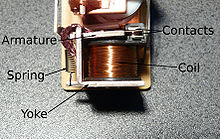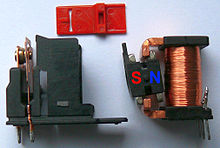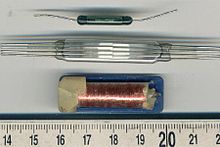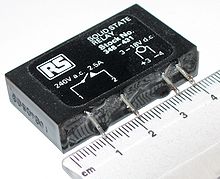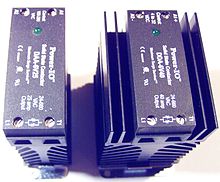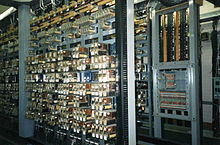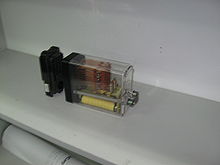- Relay
-
 Automotive-style miniature relay, dust cover is taken off
Automotive-style miniature relay, dust cover is taken off
A relay is an electrically operated switch. Many relays use an electromagnet to operate a switching mechanism mechanically, but other operating principles are also used. Relays are used where it is necessary to control a circuit by a low-power signal (with complete electrical isolation between control and controlled circuits), or where several circuits must be controlled by one signal. The first relays were used in long distance telegraph circuits, repeating the signal coming in from one circuit and re-transmitting it to another. Relays were used extensively in telephone exchanges and early computers to perform logical operations.
A type of relay that can handle the high power required to directly control an electric motor is called a contactor. Solid-state relays control power circuits with no moving parts, instead using a semiconductor device to perform switching. Relays with calibrated operating characteristics and sometimes multiple operating coils are used to protect electrical circuits from overload or faults; in modern electric power systems these functions are performed by digital instruments still called "protective relays".
Contents
Basic design and operation
 Small "cradle" relay often used in electronics. The "cradle" term refers to the shape of the relay's armature.
Small "cradle" relay often used in electronics. The "cradle" term refers to the shape of the relay's armature.
A simple electromagnetic relay consists of a coil of wire surrounding a soft iron core, an iron yoke which provides a low reluctance path for magnetic flux, a movable iron armature, and one or more sets of contacts (there are two in the relay pictured). The armature is hinged to the yoke and mechanically linked to one or more sets of moving contacts. It is held in place by a spring so that when the relay is de-energized there is an air gap in the magnetic circuit. In this condition, one of the two sets of contacts in the relay pictured is closed, and the other set is open. Other relays may have more or fewer sets of contacts depending on their function. The relay in the picture also has a wire connecting the armature to the yoke. This ensures continuity of the circuit between the moving contacts on the armature, and the circuit track on the printed circuit board (PCB) via the yoke, which is soldered to the PCB.
When an electric current is passed through the coil it generates a magnetic field that attracts the armature, and the consequent movement of the movable contact(s) either makes or breaks (depending upon construction) a connection with a fixed contact. If the set of contacts was closed when the relay was de-energized, then the movement opens the contacts and breaks the connection, and vice versa if the contacts were open. When the current to the coil is switched off, the armature is returned by a force, approximately half as strong as the magnetic force, to its relaxed position. Usually this force is provided by a spring, but gravity is also used commonly in industrial motor starters. Most relays are manufactured to operate quickly. In a low-voltage application this reduces noise; in a high voltage or current application it reduces arcing.
When the coil is energized with direct current, a diode is often placed across the coil to dissipate the energy from the collapsing magnetic field at deactivation, which would otherwise generate a voltage spike dangerous to semiconductor circuit components. Some automotive relays include a diode inside the relay case. Alternatively, a contact protection network consisting of a capacitor and resistor in series (snubber circuit) may absorb the surge. If the coil is designed to be energized with alternating current (AC), a small copper "shading ring" can be crimped to the end of the solenoid, creating a small out-of-phase current which increases the minimum pull on the armature during the AC cycle.[1]
A solid-state relay uses a thyristor or other solid-state switching device, activated by the control signal, to switch the controlled load, instead of a solenoid. An optocoupler (a light-emitting diode (LED) coupled with a photo transistor) can be used to isolate control and controlled circuits.
Types
Latching relay
A latching relay has two relaxed states (bistable). These are also called "impulse", "keep", or "stay" relays. When the current is switched off, the relay remains in its last state. This is achieved with a solenoid operating a ratchet and cam mechanism, or by having two opposing coils with an over-center spring or permanent magnet to hold the armature and contacts in position while the coil is relaxed, or with a remanent core. In the ratchet and cam example, the first pulse to the coil turns the relay on and the second pulse turns it off. In the two coil example, a pulse to one coil turns the relay on and a pulse to the opposite coil turns the relay off. This type of relay has the advantage that one coil consumes power only for an instant, while it is being switched, and the relay contacts retain this setting across a power outage. A remanent core latching relay requires a current pulse of opposite polarity to make it change state
Reed relay
A reed relay is a reed switch enclosed in a solenoid. The switch has a set of contacts inside an evacuated or inert gas-filled glass tube which protects the contacts against atmospheric corrosion; the contacts are made of magnetic material that makes them move under the influence of the field of the enclosing solenoid. Reed relays can switch faster than larger relays, require only little power from the control circuit, but have low switching current and voltage ratings. In addition, the reeds can become magnetized over time, which makes them stick 'on' even when no current is present; changing the orientation of the reeds with respect to the solenoid's magnetic field will fix the problem.
Mercury-wetted relay
A mercury-wetted reed relay is a form of reed relay in which the contacts are wetted with mercury. Such relays are used to switch low-voltage signals (one volt or less) where the mercury reduces the contact resistance and associated voltage drop, for low-current signals where surface contamination may make for a poor contact, or for high-speed applications where the mercury eliminates contact bounce. Mercury wetted relays are position-sensitive and must be mounted vertically to work properly. Because of the toxicity and expense of liquid mercury, these relays are now rarely used. See also mercury switch.
Polarized relay
A polarized relay placed the armature between the poles of a permanent magnet to increase sensitivity. Polarized relays were used in middle 20th Century telephone exchanges to detect faint pulses and correct telegraphic distortion. The poles were on screws, so a technician could first adjust them for maximum sensitivity and then apply a bias spring to set the critical current that would operate the relay.
Machine tool relay
A machine tool relay is a type standardized for industrial control of machine tools, transfer machines, and other sequential control. They are characterized by a large number of contacts (sometimes extendable in the field) which are easily converted from normally-open to normally-closed status, easily replaceable coils, and a form factor that allows compactly installing many relays in a control panel. Although such relays once were the backbone of automation in such industries as automobile assembly, the programmable logic controller (PLC) mostly displaced the machine tool relay from sequential control applications.
A relay allows circuits to be switched by electrical equipment: for example, a timer circuit with a relay could switch power at a preset time. For many years relays were the standard method of controlling industrial electronic systems. A number of relays could be used together to carry out complex functions (relay logic). The principle of relay logic is based on relays which energize and de-energize associated contacts. Relay logic is the predecessor of ladder logic, which is commonly used in Programmable logic controllers.
Ratchet relay
This is again a clapper type relay which does not need continuous current through its coil to retain its operation.
Contactor relay
A contactor is a very heavy-duty relay used for switching electric motors and lighting loads, although contactors are not generally called relays. Continuous current ratings for common contactors range from 10 amps to several hundred amps. High-current contacts are made with alloys containing silver. The unavoidable arcing causes the contacts to oxidize; however, silver oxide is still a good conductor.[2] Such devices are often used for motor starters. A motor starter is a contactor with overload protection devices attached. The overload sensing devices are a form of heat operated relay where a coil heats a bi-metal strip, or where a solder pot melts, releasing a spring to operate auxiliary contacts. These auxiliary contacts are in series with the coil. If the overload senses excess current in the load, the coil is de-energized. Contactor relays can be extremely loud to operate, making them unfit for use where noise is a chief concern.
Solid-state relay
A solid state relay (SSR) is a solid state electronic component that provides a similar function to an electromechanical relay but does not have any moving components, increasing long-term reliability. With early SSR's, the tradeoff came from the fact that every transistor has a small voltage drop across it. This voltage drop limited the amount of current a given SSR could handle. The minimum voltage drop for such a relay is equal to the voltage drop across one transistor (~0.6-2.0 volts), and is a function of the material used to make the transistor (typically silicon). As transistors improved, higher current SSR's, able to handle 100 to 1,200 Amperes, have become commercially available. Compared to electromagnetic relays, they may be falsely triggered by transients.
Solid state contactor relay
A solid state contactor is a heavy-duty solid state relay, including the necessary heat sink, used for switching electric heaters, small electric motors and lighting loads; where frequent on/off cycles are required. There are no moving parts to wear out and there is no contact bounce due to vibration. They are activated by AC control signals or DC control signals from Programmable logic controller (PLCs), PCs, Transistor-transistor logic (TTL) sources, or other microprocessor and microcontroller controls.
Buchholz relay
A Buchholz relay is a safety device sensing the accumulation of gas in large oil-filled transformers, which will alarm on slow accumulation of gas or shut down the transformer if gas is produced rapidly in the transformer oil.
Forced-guided contacts relay
A forced-guided contacts relay has relay contacts that are mechanically linked together, so that when the relay coil is energized or de-energized, all of the linked contacts move together. If one set of contacts in the relay becomes immobilized, no other contact of the same relay will be able to move. The function of forced-guided contacts is to enable the safety circuit to check the status of the relay. Forced-guided contacts are also known as "positive-guided contacts", "captive contacts", "locked contacts", or "safety relays".
Overload protection relay
Electric motors need overcurrent protection to prevent damage from over-loading the motor, or to protect against short circuits in connecting cables or internal faults in the motor windings.[3] One type of electric motor overload protection relay is operated by a heating element in series with the electric motor. The heat generated by the motor current heats a bimetallic strip or melts solder, releasing a spring to operate contacts. Where the overload relay is exposed to the same environment as the motor, a useful though crude compensation for motor ambient temperature is provided.
Pole and throw
Since relays are switches, the terminology applied to switches is also applied to relays. A relay will switch one or more poles, each of whose contacts can be thrown by energizing the coil in one of three ways:
- Normally-open (NO) contacts connect the circuit when the relay is activated; the circuit is disconnected when the relay is inactive. It is also called a Form A contact or "make" contact. NO contacts can also be distinguished as "early-make" or NOEM, which means that the contacts will close before the button or switch is fully engaged.
- Normally-closed (NC) contacts disconnect the circuit when the relay is activated; the circuit is connected when the relay is inactive. It is also called a Form B contact or "break" contact. NC contacts can also be distinguished as "late-break" or NCLB, which means that the contacts will stay closed until the button or switch is fully disengaged.
- Change-over (CO), or double-throw (DT), contacts control two circuits: one normally-open contact and one normally-closed contact with a common terminal. It is also called a Form C contact or "transfer" contact ("break before make"). If this type of contact utilizes a "make before break" functionality, then it is called a Form D contact.
The following designations are commonly encountered:
- SPST – Single Pole Single Throw. These have two terminals which can be connected or disconnected. Including two for the coil, such a relay has four terminals in total. It is ambiguous whether the pole is normally open or normally closed. The terminology "SPNO" and "SPNC" is sometimes used to resolve the ambiguity.
- SPDT – Single Pole Double Throw. A common terminal connects to either of two others. Including two for the coil, such a relay has five terminals in total.
- DPST – Double Pole Single Throw. These have two pairs of terminals. Equivalent to two SPST switches or relays actuated by a single coil. Including two for the coil, such a relay has six terminals in total. The poles may be Form A or Form B (or one of each).
- DPDT – Double Pole Double Throw. These have two rows of change-over terminals. Equivalent to two SPDT switches or relays actuated by a single coil. Such a relay has eight terminals, including the coil.
The "S" or "D" may be replaced with a number, indicating multiple switches connected to a single actuator. For example 4PDT indicates a four pole double throw relay (with 14 terminals).
EN 50005 are among applicable standards for relay terminal numbering; a typical EN 50005-compliant SPDT relay's terminals would be numbered 11, 12, 14, A1 and A2 for the C, NC, NO, and coil connections, respectively.
Applications
Relays are used to and for:
- Amplify a digital signal, switching a large amount of power with a small operating power. Some special cases are:
- A telegraph relay, repeating a weak signal received at the end of a long wire
- Controlling a high-voltage circuit with a low-voltage signal, as in some types of modems or audio amplifiers,
- Controlling a high-current circuit with a low-current signal, as in the starter solenoid of an automobile,
- Detect and isolate faults on transmission and distribution lines by opening and closing circuit breakers (protection relays),
- Isolate the controlling circuit from the controlled circuit when the two are at different potentials, for example when controlling a mains-powered device from a low-voltage switch. The latter is often applied to control office lighting as the low voltage wires are easily installed in partitions, which may be often moved as needs change. They may also be controlled by room occupancy detectors in an effort to conserve energy,
- Logic functions. For example, the boolean AND function is realised by connecting normally open relay contacts in series, the OR function by connecting normally open contacts in parallel. The change-over or Form C contacts perform the XOR (exclusive or) function. Similar functions for NAND and NOR are accomplished using normally closed contacts. The Ladder programming language is often used for designing relay logic networks.
- The application of Boolean Algebra to relay circuit design was formalized by Claude Shannon in A Symbolic Analysis of Relay and Switching Circuits
- Early computing. Before vacuum tubes and transistors, relays were used as logical elements in digital computers. See electro-mechanical computers such as ARRA (computer), Harvard Mark II, Zuse Z2, and Zuse Z3.
- Safety-critical logic. Because relays are much more resistant than semiconductors to nuclear radiation, they are widely used in safety-critical logic, such as the control panels of radioactive waste-handling machinery.
- Time delay functions. Relays can be modified to delay opening or delay closing a set of contacts. A very short (a fraction of a second) delay would use a copper disk between the armature and moving blade assembly. Current flowing in the disk maintains magnetic field for a short time, lengthening release time. For a slightly longer (up to a minute) delay, a dashpot is used. A dashpot is a piston filled with fluid that is allowed to escape slowly. The time period can be varied by increasing or decreasing the flow rate. For longer time periods, a mechanical clockwork timer is installed.
Relay application considerations
 A large relay with two coils and many sets of contacts, used in an old telephone switching system.
A large relay with two coils and many sets of contacts, used in an old telephone switching system.
Selection of an appropriate relay for a particular application requires evaluation of many different factors:
- Number and type of contacts – normally open, normally closed, (double-throw)
- Contact sequence – "Make before Break" or "Break before Make". For example, the old style telephone exchanges required Make-before-break so that the connection didn't get dropped while dialing the number.
- Rating of contacts – small relays switch a few amperes, large contactors are rated for up to 3000 amperes, alternating or direct current
- Voltage rating of contacts – typical control relays rated 300 VAC or 600 VAC, automotive types to 50 VDC, special high-voltage relays to about 15 000 V
- Operating lifetime, useful life - the number of times the relay can be expected to operate reliably. There is both a mechanical life and a contact life; the contact life is naturally affected by the kind of load being switched.
- Coil voltage – machine-tool relays usually 24 VAC, 120 or 250 VAC, relays for switchgear may have 125 V or 250 VDC coils, "sensitive" relays operate on a few milliamperes
- Coil current - including minimum current required to operate reliably and minimum current to hold. Also effects of power dissipation on coil temperature at various duty cycles.
- Package/enclosure – open, touch-safe, double-voltage for isolation between circuits, explosion proof, outdoor, oil and splash resistant, washable for printed circuit board assembly
- Operating environment - minimum and maximum operating temperatures and other environmental considerations such as effects of humidity and salt
- Assembly – Some relays feature a sticker that keeps the enclosure sealed to allow PCB post soldering cleaning, which is removed once assembly is complete.
- Mounting – sockets, plug board, rail mount, panel mount, through-panel mount, enclosure for mounting on walls or equipment
- Switching time – where high speed is required
- "Dry" contacts – when switching very low level signals, special contact materials may be needed such as gold-plated contacts
- Contact protection – suppress arcing in very inductive circuits
- Coil protection – suppress the surge voltage produced when switching the coil current
- Isolation between coil circuit and contacts
- Aerospace or radiation-resistant testing, special quality assurance
- Expected mechanical loads due to acceleration – some relays used in aerospace applications are designed to function in shock loads of 50 g or more
- Accessories such as timers, auxiliary contacts, pilot lamps, test buttons
- Regulatory approvals
- Stray magnetic linkage between coils of adjacent relays on a printed circuit board.
There are many considerations involved in the correct selection of a control relay for a particular application. These considerations include factors such as speed of operation, sensitivity, and hysteresis. Although typical control relays operate in the 5 ms to 20 ms range, relays with switching speeds as fast as 100 us are available. Reed relays which are actuated by low currents and switch fast are suitable for controlling small currents.
As for any switch, the current through the relay contacts (unrelated to the current through the coil) must not exceed a certain value to avoid damage. In the particular case of high-inductance circuits such as motors other issues must be addressed. When a power source is connected to an inductance, an input surge current which may be several times larger than the steady current exists. When the circuit is broken, the current cannot change instantaneously, which creates a potentially damaging spark across the separating contacts.
Consequently for relays which may be used to control inductive loads we must specify the maximum current that may flow through the relay contacts when it actuates, the make rating; the continuous rating; and the break rating. The make rating may be several times larger than the continuous rating, which is itself larger than the break rating.
Derating factors
Type of load % of rated value Resistive 75 Inductive 35 Motor 20 Filament 10 Capacitive 75 Control relays should not be operated above rated temperature because of resulting increased degradation and fatigue. Common practice is to derate 20 degrees Celsius from the maximum rated temperature limit. Relays operating at rated load are also affected by their environment. Oil vapors may greatly decrease the contact tip life, and dust or dirt may cause the tips to burn before their normal life expectancy. Control relay life cycle varies from 50,000 to over one million cycles depending on the electrical loads of the contacts, duty cycle, application, and the extent to which the relay is derated. When a control relay is operating at its derated value, it is controlling a lower value of current than its maximum make and break ratings. This is often done to extend the operating life of the control relay. The table lists the relay derating factors for typical industrial control applications.
Undesired arcing
Main article: Arc suppressionWithout adequate contact protection, the occurrence of electric current arcing causes significant degradation of the contacts in relays, which suffer significant and visible damage. Every time a relay transitions either from a closed to an open state (break arc) or from an open to a closed state (make arc & bounce arc), under load, an electrical arc occurs between the two contact points (electrodes) of the relay. The break arc is typically more energetic and thus more destructive.
The energy contained in the resulting electrical arc is very high (tens of thousands of degrees Fahrenheit), causing the metal on the contact surfaces to melt, pool and migrate with the current. The extremely high temperature of the arc cracks the surrounding gas molecules creating ozone, carbon monoxide, and other compounds. The arc energy slowly destroys the contact metal, causing some material to escape into the air as fine particulate matter. This very activity causes the material in the contacts to degrade quickly, resulting in device failure. This contact degradation drastically limits the overall life of a relay to a range of about 10,000 to 100,000 operations, a level far below the mechanical life of the same device, which can be in excess of 20 million operations.[4]
Protective relays
For protection of electrical apparatus and transmission lines, electromechanical relays with accurate operating characteristics were used to detect overload, short-circuits, and other faults. While many such relays remain in use, digital devices now provide equivalent protective functions.
Railway signalling
Railway signalling relays are very big and cumbersome compared to the mostly small voltages (less than 120 V) and currents (perhaps 100 mA) that they switch. Contacts are widely spaced to prevent dangerous flashovers and short circuits over a lifetime that may exceed fifty years. BR930 series plug-in relays are widely used on railways following British practice. These are 120 mm high, 180 mm deep and 56 mm wide and weigh about 1400 g, and can have up to 16 separate contacts, say 12 make and 4 break contacts.
Since rail signal circuits must be highly reliable, special techniques are used to detect and prevent failures in the relay system. To protect against false feeds, double switching relay contacts are often used on both the positive and negative side of a circuit, so that two false feeds are needed to cause a false signal. Not all relay circuits can be proved so there is reliance on construction features such as carbon to silver contacts to resist lightning induced contact welding and to provide AC immunity.
Opto-isolators are also used in some instances with railway signalling, especially where only a single contact is to be switched.
Signalling relays and their circuits come in a number of schools, including:
American signaling relays are the origin of the 19 inch rack.
History
A simple device, which we now call a relay, was included in the original 1840 telegraph patent[5] of Samuel Morse. The mechanism described acted as a digital amplifier, repeating the telegraph signal, and thus allowing signals to be propagated as far as desired. This overcame the problem of limited range of earlier telegraphy schemes.
The earlier ‘relay’ or ‘repeater’ of Edward Davy of 1837/1838 was used in his electric telegraph.
See also
- Contactor
- Digital protective relay
- Dry contact
- Race condition
- Stepping switch - a kind of multi-position relay
- Wire spring relay
References
- ^ Mason, C. R.. "Art & Science of Protective Relaying, Chapter 2, GE Consumer & Electrical". http://www.gedigitalenergy.com/multilin/notes/artsci/. Retrieved October 09, 2011.
- ^ Kenneth B. Rexford and Peter R. Giuliani (2002). Electrical control for machines (6th ed.). Cengage Learning. p. 58. ISBN 978-0-7668-6198-5. http://books.google.com/books?id=5RkbwbYq1joC&pg=PA58&lpg=PA58&dq=silver-oxide+relay+contact#v=onepage&q=silver-oxide%20relay%20contact&f=false.
- ^ Zocholl, Stan (2003). AC Motor Protection. Schweitzer Engineering Laboratories, Inc.. ISBN 0972502610, 978-0972502610.
- ^ "Lab Note #105 Contact Life - Unsuppressed vs. Suppressed Arcing". Arc Suppression Technologies. April 2011. http://arcsuppressiontechnologies.com/Documents/Lab%20Note%20105%20-%20APR2011%20-%20Contact%20Life%20100K.pdf. Retrieved October 09, 2011.
- ^ US Patent 1,647, Improvement in the mode of communicating information by signals by the application of electro-magnetism, June 20, 1840
- Gurevich, Vladimir (2005). Electrical Relays: Principles and Applications. London - New York: CRC Press.
- Westinghouse Corporation (1976). Applied Protective Relaying. Westinghouse Corporation. Library of Congress card no. 76-8060.
- Terrell Croft and Wilford Summers (ed) (1987). American Electricians' Handbook, Eleventh Edition. New York: McGraw Hill. ISBN 978-0-07-013932-9.
- Walter A. Elmore. Protective Relaying Theory and Applications. Marcel Dekker, Inc.. ISBN 978-0-8247-9152-0.
- Vladimir Gurevich (2008). Electronic Devices on Discrete Components for Industrial and Power Engineering. London - New York: CRC Press. p. 418.
- Vladimir Gurevich (2003). Protection Devices and Systems for High-Voltage Applications. London - New York: CRC Press. p. 292.
- Vladimir Gurevich (2010). Digital Protective Relays: Problems and Solutions. London - New York: CRC Press. p. 422.
- Colin Simpson, Principles of Electronics, Prentice-Hall, 2002, ISBN 0-0686860-3-6
External links
Categories:- Electromagnetic components
- Relay switches
- Transducers
- Power engineering
Wikimedia Foundation. 2010.

